The control program carried out in the health centers.Through a retina photograph, it detects premature injuries caused by diabetes.
"The results are spectacular and we are preventing diabetic patients from losing their sight," says the Director of Health Care.
For years, health administrations have been committed more and more for prevention and early detection strategies of pathologies as measures to stop the disease, promote health and lighten the costs and pressure that the socio-sanitary system supports.Following these objectives, numerous preventive programs are designed and applied, as well as control of the evolution of chronic pathologies, whose effectiveness reflects the data.
In the case of Health Area III, two new screening initiatives from Primary Care have been launched in recent years: the Biennial Control Program with retinographies to diabetic patients, which is carried out in health centers since 2014, andThe population screening plan of colorectal cancer implemented in the health area III since 2016.
"An essential condition for adequate to implement a screening in a population is that it detects early injuries that have a treatment that modifies the evolution of the disease, getting to stop it, slow or cure it," says the Director of Health Care and Health and HealthPublic of the area, Lidia Clara Rodríguez.
Regarding the control program with diabetic retinographies, Rodríguez states that "the results obtained are spectacular in the percentage of diabetes patients who have an eye fund in primary care in the last two years."According to data registered by the Health Care Service, since the implementation of the Early Diabetic Retinopathy Detection Program, the number of patients who have undergone the control that is carried out every two years increased by about 50%.
«When this program was launched, 12% of patients had performed the test in the last two years.And in December 2017 they had done it 56%.The figure continues to grow, since in April 2018 it was already 60%, ”says Rodríguez. For this health manager,“ the great value of this plan is that detecting the lesions early we avoid blindness and early treatment can be done ».
People suffering from type II diabetes are at risk of damage to the retina and can even lose sight.The retinography, a test that consists of "taking a photo of the retina", has shown "a great efficacy in preventing the injuries produced by diabetes as the years of disease progress," explains the head of health care and public health.
Another of the positive consequences of the application of this program from Primary Care has been the reduction of the waiting lists of the ophthalmology service, since the retinographies are not carried out in the San Agustín, but in the health centers, with whichYou win in agility.
The family doctor is in charge of evaluating the test.If you do not detect abnormal in the image, the patient is referred to the next control, which will be performed within two years.On the other hand, if injuries are detected or if the image of the retina obtained is doubtful, it is sent to the ophthalmology service and it is the professional of this department who values it without the need for the patient to go to his consultation."If it is necessary to examine it, and if you do not report to the family doctor the treatment recommendations or to perform a more exhaustive control," says Rodríguez.
In 2017, area III health centers practiced retinographies to a total of 3,043 patients with diabetes.Of all of them, «the family doctor only had to send25% to ophthalmologist.And of that 25%, they specified a face -to -face consultation in ophthalmology only 5%, ”he says.This assumes that "95% of patients who used to go to ophthalmology for retinal control no longer have to do it," Rodríguez explains.
New technologies have expedited this diagnostic test and the traditional ophthalmoscope has been replaced by digital retinographer.«Area III has a device that is periodically sent to each of the ten existing health centers.Depending on the size of each center, the retinographer remains in it "for a month or month and a half."
But retinography is not the only screening test that has begun to be carried out in primary care centers.Since October 2016, a population screening of colorectal cancer is also carried out in area III, which in 2015 had already developed a piloting in the health centers of Cudillero and Castrillón.
The objective of this campaign is to detect a type of cancer that is usually asymptomatic until it reaches its advanced phases and affects one in twenty people.In its initial phases it can be cured, in fact, it is estimated that the screening can avoid between 15 and 33% the number of deaths caused by this serious disease.
The test is biennial and is aimed at people between 50 and 69, who are sent a letter inviting them to participate in the program.«We do a hidden blood test to the population of every two years.If the test is positive, the family doctor quotes the person to explain why it is convenient for a colonoscopy to be made, proof that imposes a lot to some and does not accept but is less and less annoying is done with superficial sedation, ”explains LidiaClara Rodríguez.
At the moment it exceeds 41% of the population that receives the letter participates in the program, and of those who positive in the first test that is carried out in the health center and goes to do this colonoscopy, 8 out of 10 confirm theresult and colon cancer is diagnosed."The participation fact is good considering that the program has implanted less than two years, but we hope it grows much more," says Rodríguez.


